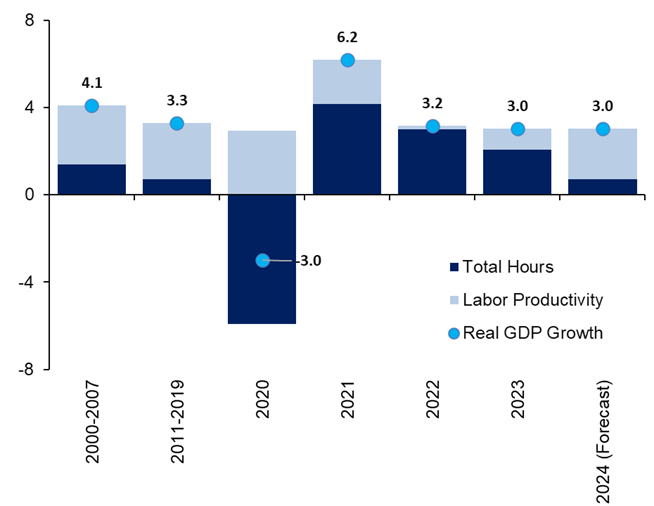
For an overview of charts and tables, please see the Total Economy Database Summary Tables and Charts, available here.
This release includes updated and revised estimates of the labor productivity and growth accounting variables (including TFP). See our revision notes for the most important changes.
The data can be downloaded through The Conference Board Data Central. Please create an account with The Conference Board for complimentary access to all data files.
The Covid-19 pandemic created a lot of macro volatility. One of those impacts was the severe disruption of labor markets due to economy-wide shutdowns in many regions of the World. Global employment fell by 1.9% in 2020. But it was the more dramatic 5.9% decline in total hours worked that really highlighted the full extent of the shock. In the years after 2020, as economies reopened, the rebound in hours worked accounted for much of the GDP growth during that period.
Real GDP growth can be decomposed into contributions from total hours worked (increasing the quantity of labor) and from labor productivity (increasing the output per hour worked). In the three years following the pandemic shock, real GDP growth was largely dominated by the rebound in hours. Between 2021 and 2023, the latter accounted for 73% of total GDP growth, with labor productivity growth contributing the remaining 27%.
Forecasts for 2024 now indicate a shift back towards a more labor productivity-driven growth environment. We expect Global GDP growth to maintain the 3% pace we saw in 2022 and 2023. Yet, in contrast to the last two years, a substantial 77% of the 2024 GDP growth rate is expected to come from accelerated labor productivity gains. It mirrors the two decades before the pandemic when the contribution from labor productivity averaged 72%, and it is a clear indication that macroeconomic conditions are returning to normal.
The question is, will that new trend be sustainable? The problem is increasing labor shortages will constrain growth in employment and total hours worked. There is still room to raise the participation of women and older workers in the labor force. But population growth is slowing, and the political climate is turning against more immigration. That means improving the rate of labor productivity growth will increasingly become the only way to generate future GDP growth. The good news is the chances of achieving such an improvement look encouragingly good. Investment as a share of GDP is expected to rise in the next five years. Furthermore, technological breakthroughs like the broader adoption of generative AI can potentially transform that investment into meaningful productivity gains.
Chart: Labor productivity is expected to reclaim its role as the dominant driver of global economic growth as the post-pandemic rebound in Labor Inputs normalizes
Contribution of Growth of Labor Productivity, Total Hours Worked to Global GDP growth, 2000-2023, log percentage points.

Source: The Conference Board Total Economy Database™ May 2024
Before using the data, please consider the following:
The data can be downloaded through The Conference Board Data Central. On Data Central the Total Economy Database is presented in two sections: 1) Growth Accounting and Total Factor Productivity, and 2) Output, Labor and Labor Productivity.
The Growth Accounting and Total Factor Productivity dataset contains time series data on the contributions of factor inputs - labor (Labor Quantity and Labor Quality), capital (Non-ICT Capital Services and ICT Capital Services) and Total Factor Productivity Growth (TFPG) - to GDP growth, obtained using a growth accounting method. The file also contains data on the Share of Labor Compensation in GDP which is used to assign weights to the factor inputs in deriving their contributions to GDP growth.
The Output, Labor and Labor Productivity dataset contains time series data on Gross Domestic Product (GDP), Population, Employment, Total Hours Worked, Per Capita Income and Labor Productivity (measured as GDP per Person Employed and GDP per Hour Worked).
All downloadable files, including all data series in the Total Economy Database™ (“TED”) are protected by United States and international copyright laws. The Conference Board, Inc. reserves all rights afforded to it under the law. All series must be cited as: “The Conference Board Total Economy Database™, April 2023”. Data is made available for personal, non-commercial analysis purposes only (e.g. internal use, academic use, or fair use), and not for reproduction, redistribution, resale, publication, databasing, public posting, creation of derivative works, or any other use without the express written permission of The Conference Board, Inc.
To request permission for a reprint request, please send a completed copy of this request form to TED@tcb.org. The use of all TCB data and materials is subject to the Terms of Use. Reprint requests are reviewed individually and may be subject to additional fees. TCB reserves the right to deny any request.
TED - Sources & Methods - General Description (1 page)
TED - Sources & Methods - Detailed Description (Version: April 2022)
The Total Economy Database™, (TED) is a comprehensive database with annual data covering GDP, population, employment, hours, labor quality, capital services, labor productivity, and Total Factor Productivity for 131 countries in the world.
United States data are presented in two series, 'United States' and 'United States (Adjusted)'. The first is based on official government data, while the adjusted series refers to our alternative GDP series for the US which are revised upward as they are based on alternative price deflators for ICT investment goods and services. The adjustment factors were revised and updated in August 2021.
Chinese data is presented in two series, 'China' and 'China (Alternative)'. The first is based on official government data, while 'China (Alternative)' represents alternative growth numbers, based on the work of Prof. Harry X. Wu, Hitotsubashi University. The data were last updated and revised in April 2022.
TED was developed by the Groningen Growth and Development Centre (University of Groningen, The Netherlands) in the early 1990s, and starting in the late 1990s, it was produced in partnership with The Conference Board. As of 2007, the database was transferred from the University of Groningen to The Conference Board, which has maintained and extended the database since then. In January 2010, the database was extended with a module on sources of growth, including labor quantity and quality, capital services (non-ICT and ICT), and Total Factor Productivity. The extended module aims to integrate two previous data sets: the world economy productivity data set created by Dale Jorgenson and Khuong Vu of Harvard University and the Total Economy Growth Accounting Database of the Groningen Growth and Development Centre.
All release times displayed are Eastern Time

Global Productivity Brief 2023
May 08, 2023 | Report

Global Productivity Brief 2021
April 21, 2021 | Report
